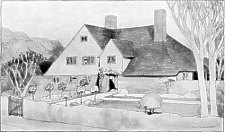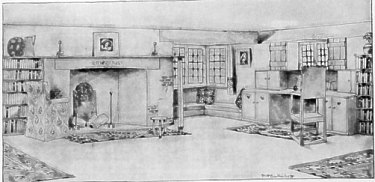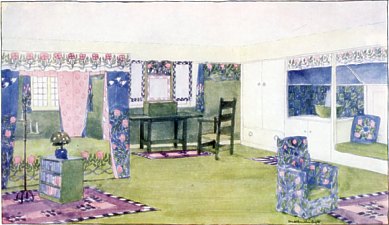
A Country Cottage
[From The Studio vol 25 No 108 March 1902]
BY

A Country Cottage
In seeking for a basis for the plan of a small house it may be well to follow the evolution of the complex modern house; and in tracing this back to its source it will be found that it originally comprised but one apartment-the hall or house place, as it was called-and if its development from this primary form is followed it will be found that it consisted chiefly in the formation of special cells for special purposes. In this gradual evolution under economic conditions, the hail-its occupation gone-gradually dwindled down to the lobby with the staircase in it, which is still dignified with the ancient title of hall in the smallest modern villa. In recent house-planning, the hall has again attained a somewhat spurious prominence. In modern times the revolt against the sordid ugliness of the Victorian house led those who aimed at recreating beauty in domestic surroundings to turn with an enthusiasm which was almost passionate to the study of the older houses where the hall played such an important part. And so, amidst other features and details of the past, the hall became again a some-what notable feature in the plan, and was considered almost an essential adjunct to the "artistic house."

The Hall in a Country Cottage
In the large house, where economic conditions of planning may give way to the fancy of the individual, this revival of the hall may perhaps be justified, and a sitting-room may well be sacrificed for the sake of a fine focus to the plan; but in the smaller houses, where every inch of space must be made the most of, such a hall was a somewhat expensive luxury, though, inasmuch as it is the mark of the modern mind to be incapable of conceiving beauty except apart from usefulness, the hall in this connection helped to give what is considered "artistic character" to a house. It was at least sufficiently useless for that ! Meanwhile, the more practical person chose rather to retain his staircase lobby, and instead of the hall to fashion for himself a third sitting-room, private and apart, where he might sit in ease and quiet. And yet it must be owned that the modern house, as it has been evolved under economic and utilitarian conditions, is not and can hardly be a thing of beauty. A series of compartments without unity or focus can never make a house. However large the rooms may be, however great their individual beauty and attractiveness, they never unite to form a consistent and coherent whole. The occupant of such a dwelling is indeed never aware of the house as a whole, but, shut in by the four walls of the particular room he happens to be living in, that room is, for the time being, the house. However beautifully its walls may be adorned, it is, after all, merely a compartment-an individual in a community of alien and unsympathetic persons without social relations or government. Still more is this want of coherence accentuated when each room is decorated and furnished in a distinct style, and it is demanded that the occupants should attune themselves in harmony with the trappings of the people of other nations and other times.
The problem which the modern designer has then to solve is how to secure the unity of effect which was a natural feature in the earlier and simpler plans, and yet to fulfil the somewhat complex requirements of modern life. In seeking for the basis for a plan which shall comply with these conditions, and in looking backward to earlier types of plans for suggestions, one is led to observe that one of the last surviving functions of the hall was the somewhat important one of dining; and it may perhaps be claimed that such a function may be taken as the central and typical feature of the domestic ritual of daily life; and home life, even it conducted on the most approved principles of plain living and high thinking, is still, to a large extent, it must be confessed, a question of meals. How, then, if one were to take a step back and make the hall a dining-hall instead of separating off a special feeding cell? The objection to the use of the average hall for this purpose would naturally be that one does not care to dine in a room which is necessarily a passage for servants and visitors, but this objection may be removed by a little planning, and so the Dining-Hall resolves itself into the focus of the plan and the family life, from which one catches a glimpse of rooms beyond-the parlour adjoining, and in a more remote privacy--the study.

A Country Cottage - the Parlour
The cottage here illustrated is submitted as an attempt to give a concrete form to the ideas which resulted from such a line of reasoning as has been briefly sketched. Access to the parlour and the kitchen premises can be obtained without passing through the main portion of the hall, and a curtain may also be introduced, if required, to screen the staircase during meals. Here on entering from the porch, with the wide doorway between parlour and hall open, one may at least feel in the house itself and not shut in by the four walls of those prison cells which we call rooms nowadays.
The walls may be covered with a plain canvas of a coarse texture, and the woodwork painted white, while the principal feature is the broad open fireplace with its spaces of red brickwork. The chairs, rush-seated with high backs, are made of unpolished wood. The floor should preferably be of hard wood and not covered with a carpet, but with a few well-chosen rugs only to ensure comfort. In these, as in the general colouring, the usual dirty drab, which seems to be the average tone of the modern dining-room, should be replaced by a certain cleanly freshness of aspect with broad spaces of pure colour and no competing patterns. In such a room a single vase of daffodils will appear almost as much at home as in their own green world, and, instead of showing as a mere trivial detail, will form such a salient feature that one feels the whole room might perhaps have been designed to show off the curves of their petals, so well do the walls and floor know their place and function. The windows follow the characteristic proportions of the room, and repeat again the prevailing horizontal line which makes for repose. Large enough to give ample light, they are not so large as to form glaring gashes in the wall, which must be shrouded in all the elaborate modern trappings of lace curtains and venetian blinds. Their leaded lines are bars of shade, which serve but to enhance the beauty of the landscape they conceal and yet reveal. Imagination which is foiled by the bald complete revelation of the plate-glass window has here a chance to play its part, and to weave a beauty of its own out of the actual facts, partially displayed. The doors, too, are of the cottage kind, wide and low, constructed of broad planks with horizontal ledges, and wrought-iron latches and hinges. Those which open into the parlour disclose a scheme of blues and greens with lilac and grey, and on the walls a few Japanese prints perhaps, broadly and simply framed.
In its general treatment it owes much to a certain negative virtue, and in the omission of the vulgar its merit chiefly lies. " Here you felt "-one might say with Walter Pater-" all had been mentally put to rights by the working out of a long equation which had zero equals zero for its result." We have all heard of the artist who obtained his effects by rubbing out, and in spite of the obvious sarcasm which the record of such a process suggests, it may perhaps be not unwisely practised by the designer of the rooms we live in. For there is so much which might well be rubbed out in the modern house, while so many of the so-called ornaments which disturb our peace might well be eliminated. And so we escape from that strange and dreadful tyranny which inanimate things have the power of exercising over their so-called possessors. We have no carpets to demand of us that annual beating which will alone reduce them to subjection, and our chairs need not be muzzled by coverings to keep them at bay. Our household gods are few and choice, and make no demands for troops of slaves to labour in their service.
The treatment of the study will depend on the tastes of its occupant. A lover of books will line its walls from floor to ceiling, perhaps, with many volumes ; a lover of sport will prefer to surround himself with weapons or trophies of the chase; or the room may be consigned to the mistress of the establishment as a workroom or as a schoolroom for the children.
On the bedroom floor five bedrooms are provided, with bath-room and lavatory, while on an attic floor accommodation is provided for servants, as well as a box-room and cistern-room.

A Country Cottage - Design for Bedroom
The example of a bedroom illustrated may perhaps require a few words in its defence in an age which is, above all things, devoted to the pursuit of the germ. In spite of prejudices to the contrary, it may be urged that a fourposter bed with washable hangings has its advantages; for the curtains shielding the occupant from draughts, the room may be flushed with fresh air, and windows left open all night without danger, while, from the artistic standpoint, such a bed is certainly more inviting than an unscreened and bare couch exposed to every draught. In the decoration of , the house generally it is suggested that, finished at first without pattern of any kind, it should be gradually adorned with carefully disposed ornaments, not executed in the hurried modern way, but done gradually as funds and time allow; and in such decoration the bedrooms may be dedicated each to a special flower. In pursuance of such a scheme, in the example shown the rose is chosen, and this bed of roses may give an opportunity for those products of the needle which generally take the form of antimacassars and other drawing-room trifles.
Unlike the sitting-rooms of the house, the bedroom is generally the outward expression of the tastes of an individual, and the personal note is necessarily more apparent. And so it will not be desirable to achieve merely that monotony of treatment which one finds, for instance, in the bedroom of the hotel, but each room should speak of the personality of its occupants. And so one may be luxurious and sumptuous, another daintily and delicately white, while a third may be of a more robust and masculine character.
The modern idea of a garden seems to be a shapeless mass of shrubs and a curved carriage drive, bordered with scarlet geraniums, calceolarias and lobelias, one of the most unfortunate combinations of flowers which the ingenuity of man is capable of devising. Another type is the formal garden, with its smooth-shaven lawns and its clipped hedges of yew and box; but the beauty of such a garden is only to be attained by a constant strife with Nature, and the occupier of the house under consideration will hardly be prepared to maintain such a warfare with constancy and success. He will not attempt, for instance, successions of flowers in his borders, but will be content with those hardy perennials which appear, unasked and unattended, year by year. In his dealings with Nature he will seek rather to take her into his confidence, and, without any desire to achieve the horrors of the landscape garden, he will not push the craft of the gardener so far as to drive Nature beyond the garden fence. If the limits of his land allow there must be an orchard, in which the quality of the fruit will not be the only consideration. In the grass under the trees daffodils, anemones, and snowdrops will proclaim the spring, and in the autumn apples falling in the deep, cool grass, and a thousand miniature suns piercing the golden green of the leaves, may form pleasant surroundings for an idle afternoon.
The garden, indeed, like the dwelling, will be of the cottage kind, of which so many beautiful examples may be found in English villages beyond the influence of villadom, and where the recent restorations to the church, and the new board school are the only blots upon the scene.
|
|
||
|
|
||
|
Any comments, errors or omissions gratefully received
The Editor © F.Coakley , 2011 |
||